Fog and Edge Computing: Advancements in Cloud-Centered IoT
VerifiedAdded on 2023/06/03
|9
|2239
|311
AI Summary
Simranbir Singh's literature review discusses the advancements in cloud-centered IoT through Fog and Edge Computing. It covers the advantages and disadvantages, applications, required educational tools, and networking connectivity of these technologies.
Contribute Materials
Your contribution can guide someone’s learning journey. Share your
documents today.

Simranbir singh 1
LITERATURE REVIEW
SIMRANBIR SINGH
Simr0008
2184716
LITERATURE REVIEW
SIMRANBIR SINGH
Simr0008
2184716
Secure Best Marks with AI Grader
Need help grading? Try our AI Grader for instant feedback on your assignments.
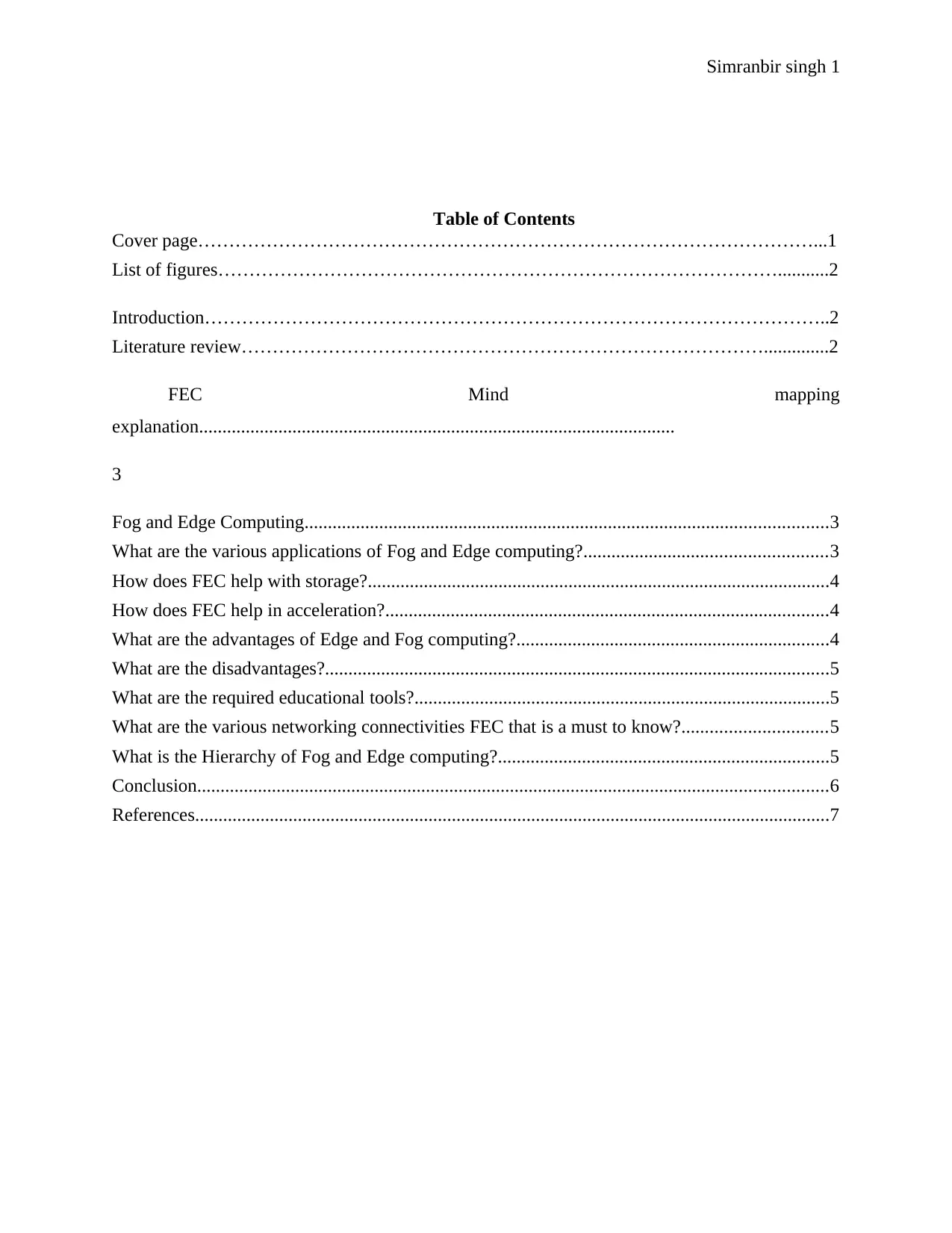
Simranbir singh 1
Table of Contents
Cover page………………………………………………………………………………………...1
List of figures………………………………………………………………………………...........2
Introduction………………………………………………………………………………………..2
Literature review…………………………………………………………………………..............2
FEC Mind mapping
explanation......................................................................................................
3
Fog and Edge Computing................................................................................................................3
What are the various applications of Fog and Edge computing?....................................................3
How does FEC help with storage?...................................................................................................4
How does FEC help in acceleration?...............................................................................................4
What are the advantages of Edge and Fog computing?...................................................................4
What are the disadvantages?............................................................................................................5
What are the required educational tools?.........................................................................................5
What are the various networking connectivities FEC that is a must to know?...............................5
What is the Hierarchy of Fog and Edge computing?.......................................................................5
Conclusion.......................................................................................................................................6
References........................................................................................................................................7
Table of Contents
Cover page………………………………………………………………………………………...1
List of figures………………………………………………………………………………...........2
Introduction………………………………………………………………………………………..2
Literature review…………………………………………………………………………..............2
FEC Mind mapping
explanation......................................................................................................
3
Fog and Edge Computing................................................................................................................3
What are the various applications of Fog and Edge computing?....................................................3
How does FEC help with storage?...................................................................................................4
How does FEC help in acceleration?...............................................................................................4
What are the advantages of Edge and Fog computing?...................................................................4
What are the disadvantages?............................................................................................................5
What are the required educational tools?.........................................................................................5
What are the various networking connectivities FEC that is a must to know?...............................5
What is the Hierarchy of Fog and Edge computing?.......................................................................5
Conclusion.......................................................................................................................................6
References........................................................................................................................................7
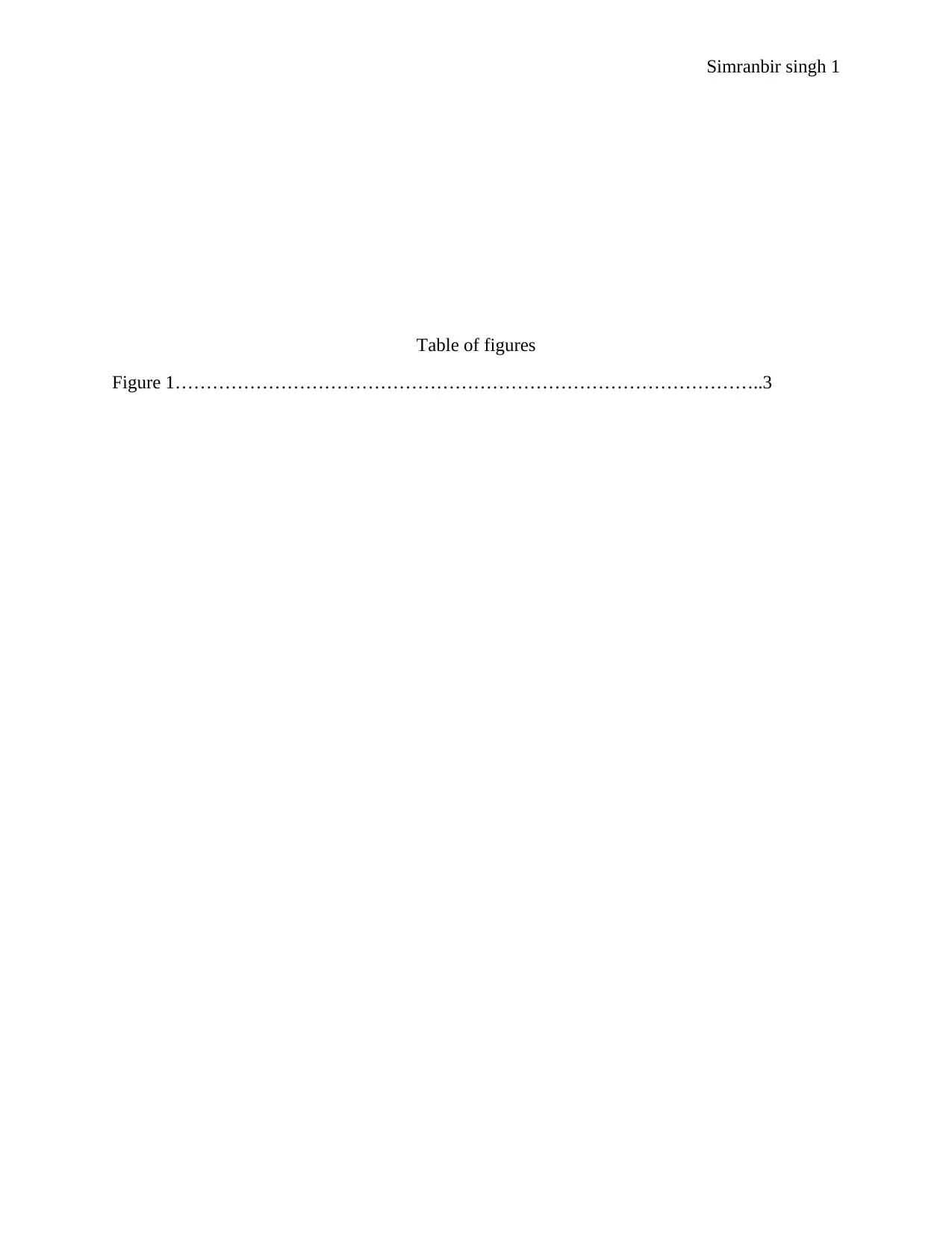
Simranbir singh 1
Table of figures
Figure 1…………………………………………………………………………………..3
Table of figures
Figure 1…………………………………………………………………………………..3
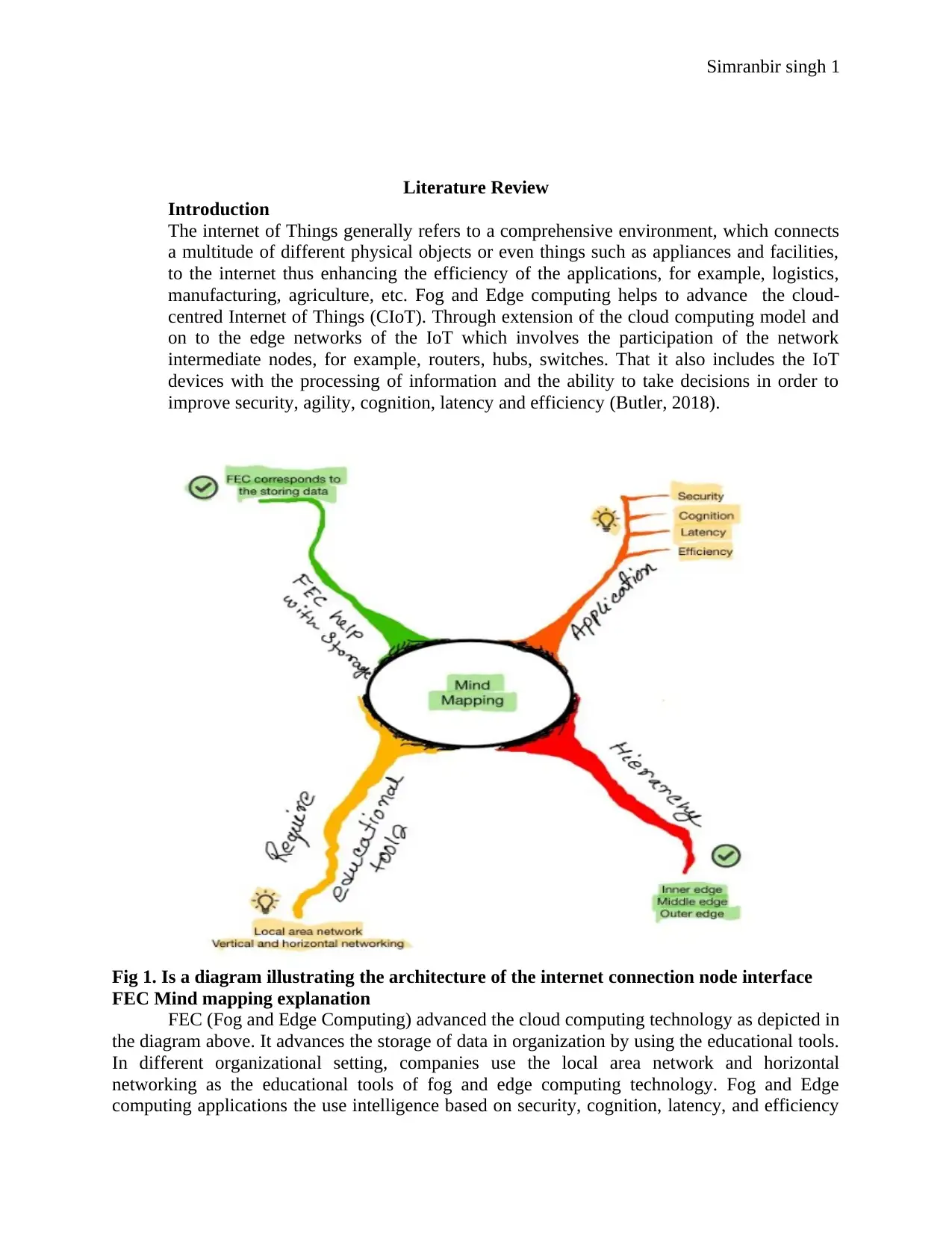
Simranbir singh 1
Literature Review
Introduction
The internet of Things generally refers to a comprehensive environment, which connects
a multitude of different physical objects or even things such as appliances and facilities,
to the internet thus enhancing the efficiency of the applications, for example, logistics,
manufacturing, agriculture, etc. Fog and Edge computing helps to advance the cloud-
centred Internet of Things (CIoT). Through extension of the cloud computing model and
on to the edge networks of the IoT which involves the participation of the network
intermediate nodes, for example, routers, hubs, switches. That it also includes the IoT
devices with the processing of information and the ability to take decisions in order to
improve security, agility, cognition, latency and efficiency (Butler, 2018).
Fig 1. Is a diagram illustrating the architecture of the internet connection node interface
FEC Mind mapping explanation
FEC (Fog and Edge Computing) advanced the cloud computing technology as depicted in
the diagram above. It advances the storage of data in organization by using the educational tools.
In different organizational setting, companies use the local area network and horizontal
networking as the educational tools of fog and edge computing technology. Fog and Edge
computing applications the use intelligence based on security, cognition, latency, and efficiency
Literature Review
Introduction
The internet of Things generally refers to a comprehensive environment, which connects
a multitude of different physical objects or even things such as appliances and facilities,
to the internet thus enhancing the efficiency of the applications, for example, logistics,
manufacturing, agriculture, etc. Fog and Edge computing helps to advance the cloud-
centred Internet of Things (CIoT). Through extension of the cloud computing model and
on to the edge networks of the IoT which involves the participation of the network
intermediate nodes, for example, routers, hubs, switches. That it also includes the IoT
devices with the processing of information and the ability to take decisions in order to
improve security, agility, cognition, latency and efficiency (Butler, 2018).
Fig 1. Is a diagram illustrating the architecture of the internet connection node interface
FEC Mind mapping explanation
FEC (Fog and Edge Computing) advanced the cloud computing technology as depicted in
the diagram above. It advances the storage of data in organization by using the educational tools.
In different organizational setting, companies use the local area network and horizontal
networking as the educational tools of fog and edge computing technology. Fog and Edge
computing applications the use intelligence based on security, cognition, latency, and efficiency
Secure Best Marks with AI Grader
Need help grading? Try our AI Grader for instant feedback on your assignments.
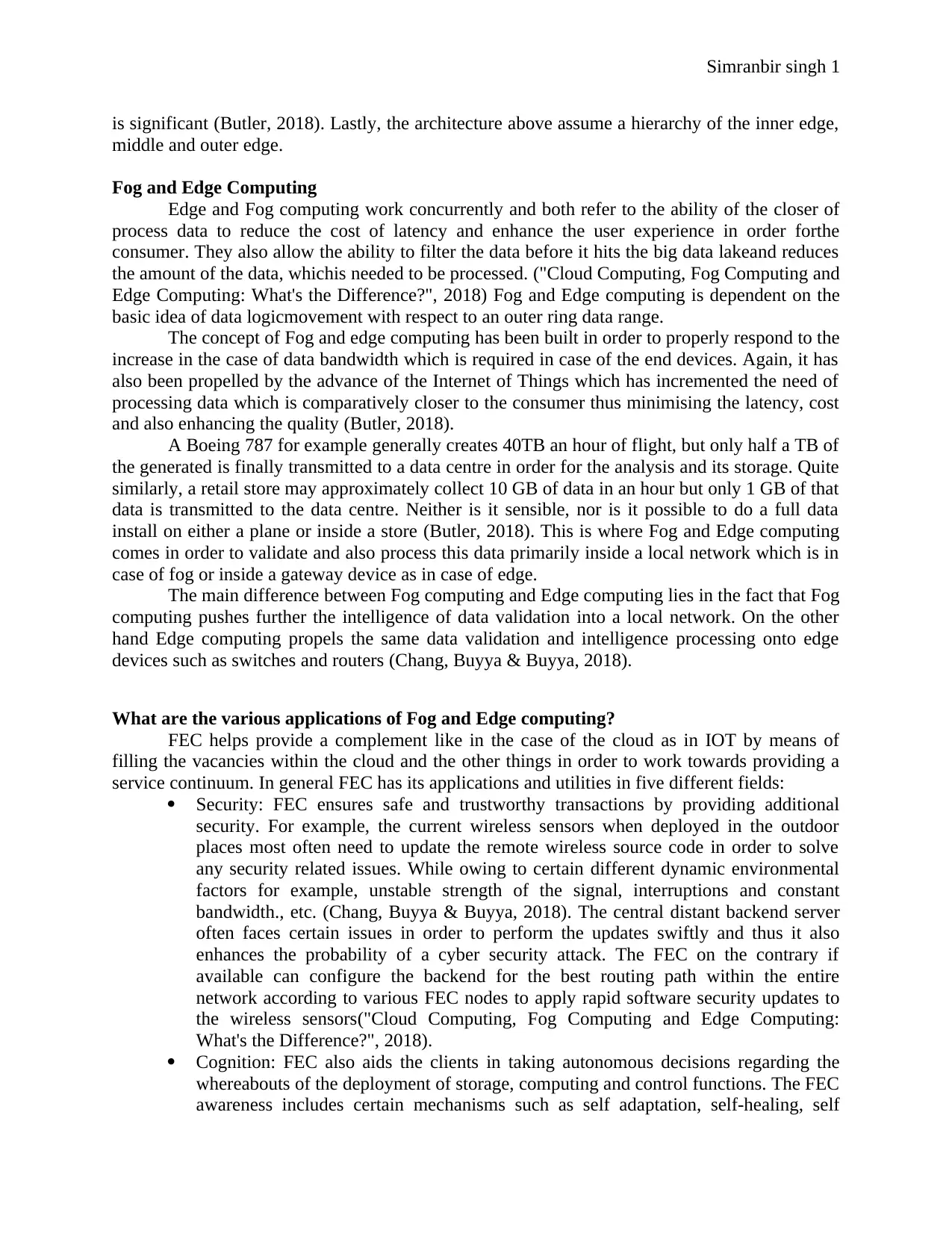
Simranbir singh 1
is significant (Butler, 2018). Lastly, the architecture above assume a hierarchy of the inner edge,
middle and outer edge.
Fog and Edge Computing
Edge and Fog computing work concurrently and both refer to the ability of the closer of
process data to reduce the cost of latency and enhance the user experience in order forthe
consumer. They also allow the ability to filter the data before it hits the big data lakeand reduces
the amount of the data, whichis needed to be processed. ("Cloud Computing, Fog Computing and
Edge Computing: What's the Difference?", 2018) Fog and Edge computing is dependent on the
basic idea of data logicmovement with respect to an outer ring data range.
The concept of Fog and edge computing has been built in order to properly respond to the
increase in the case of data bandwidth which is required in case of the end devices. Again, it has
also been propelled by the advance of the Internet of Things which has incremented the need of
processing data which is comparatively closer to the consumer thus minimising the latency, cost
and also enhancing the quality (Butler, 2018).
A Boeing 787 for example generally creates 40TB an hour of flight, but only half a TB of
the generated is finally transmitted to a data centre in order for the analysis and its storage. Quite
similarly, a retail store may approximately collect 10 GB of data in an hour but only 1 GB of that
data is transmitted to the data centre. Neither is it sensible, nor is it possible to do a full data
install on either a plane or inside a store (Butler, 2018). This is where Fog and Edge computing
comes in order to validate and also process this data primarily inside a local network which is in
case of fog or inside a gateway device as in case of edge.
The main difference between Fog computing and Edge computing lies in the fact that Fog
computing pushes further the intelligence of data validation into a local network. On the other
hand Edge computing propels the same data validation and intelligence processing onto edge
devices such as switches and routers (Chang, Buyya & Buyya, 2018).
What are the various applications of Fog and Edge computing?
FEC helps provide a complement like in the case of the cloud as in IOT by means of
filling the vacancies within the cloud and the other things in order to work towards providing a
service continuum. In general FEC has its applications and utilities in five different fields:
Security: FEC ensures safe and trustworthy transactions by providing additional
security. For example, the current wireless sensors when deployed in the outdoor
places most often need to update the remote wireless source code in order to solve
any security related issues. While owing to certain different dynamic environmental
factors for example, unstable strength of the signal, interruptions and constant
bandwidth., etc. (Chang, Buyya & Buyya, 2018). The central distant backend server
often faces certain issues in order to perform the updates swiftly and thus it also
enhances the probability of a cyber security attack. The FEC on the contrary if
available can configure the backend for the best routing path within the entire
network according to various FEC nodes to apply rapid software security updates to
the wireless sensors("Cloud Computing, Fog Computing and Edge Computing:
What's the Difference?", 2018).
Cognition: FEC also aids the clients in taking autonomous decisions regarding the
whereabouts of the deployment of storage, computing and control functions. The FEC
awareness includes certain mechanisms such as self adaptation, self-healing, self
is significant (Butler, 2018). Lastly, the architecture above assume a hierarchy of the inner edge,
middle and outer edge.
Fog and Edge Computing
Edge and Fog computing work concurrently and both refer to the ability of the closer of
process data to reduce the cost of latency and enhance the user experience in order forthe
consumer. They also allow the ability to filter the data before it hits the big data lakeand reduces
the amount of the data, whichis needed to be processed. ("Cloud Computing, Fog Computing and
Edge Computing: What's the Difference?", 2018) Fog and Edge computing is dependent on the
basic idea of data logicmovement with respect to an outer ring data range.
The concept of Fog and edge computing has been built in order to properly respond to the
increase in the case of data bandwidth which is required in case of the end devices. Again, it has
also been propelled by the advance of the Internet of Things which has incremented the need of
processing data which is comparatively closer to the consumer thus minimising the latency, cost
and also enhancing the quality (Butler, 2018).
A Boeing 787 for example generally creates 40TB an hour of flight, but only half a TB of
the generated is finally transmitted to a data centre in order for the analysis and its storage. Quite
similarly, a retail store may approximately collect 10 GB of data in an hour but only 1 GB of that
data is transmitted to the data centre. Neither is it sensible, nor is it possible to do a full data
install on either a plane or inside a store (Butler, 2018). This is where Fog and Edge computing
comes in order to validate and also process this data primarily inside a local network which is in
case of fog or inside a gateway device as in case of edge.
The main difference between Fog computing and Edge computing lies in the fact that Fog
computing pushes further the intelligence of data validation into a local network. On the other
hand Edge computing propels the same data validation and intelligence processing onto edge
devices such as switches and routers (Chang, Buyya & Buyya, 2018).
What are the various applications of Fog and Edge computing?
FEC helps provide a complement like in the case of the cloud as in IOT by means of
filling the vacancies within the cloud and the other things in order to work towards providing a
service continuum. In general FEC has its applications and utilities in five different fields:
Security: FEC ensures safe and trustworthy transactions by providing additional
security. For example, the current wireless sensors when deployed in the outdoor
places most often need to update the remote wireless source code in order to solve
any security related issues. While owing to certain different dynamic environmental
factors for example, unstable strength of the signal, interruptions and constant
bandwidth., etc. (Chang, Buyya & Buyya, 2018). The central distant backend server
often faces certain issues in order to perform the updates swiftly and thus it also
enhances the probability of a cyber security attack. The FEC on the contrary if
available can configure the backend for the best routing path within the entire
network according to various FEC nodes to apply rapid software security updates to
the wireless sensors("Cloud Computing, Fog Computing and Edge Computing:
What's the Difference?", 2018).
Cognition: FEC also aids the clients in taking autonomous decisions regarding the
whereabouts of the deployment of storage, computing and control functions. The FEC
awareness includes certain mechanisms such as self adaptation, self-healing, self
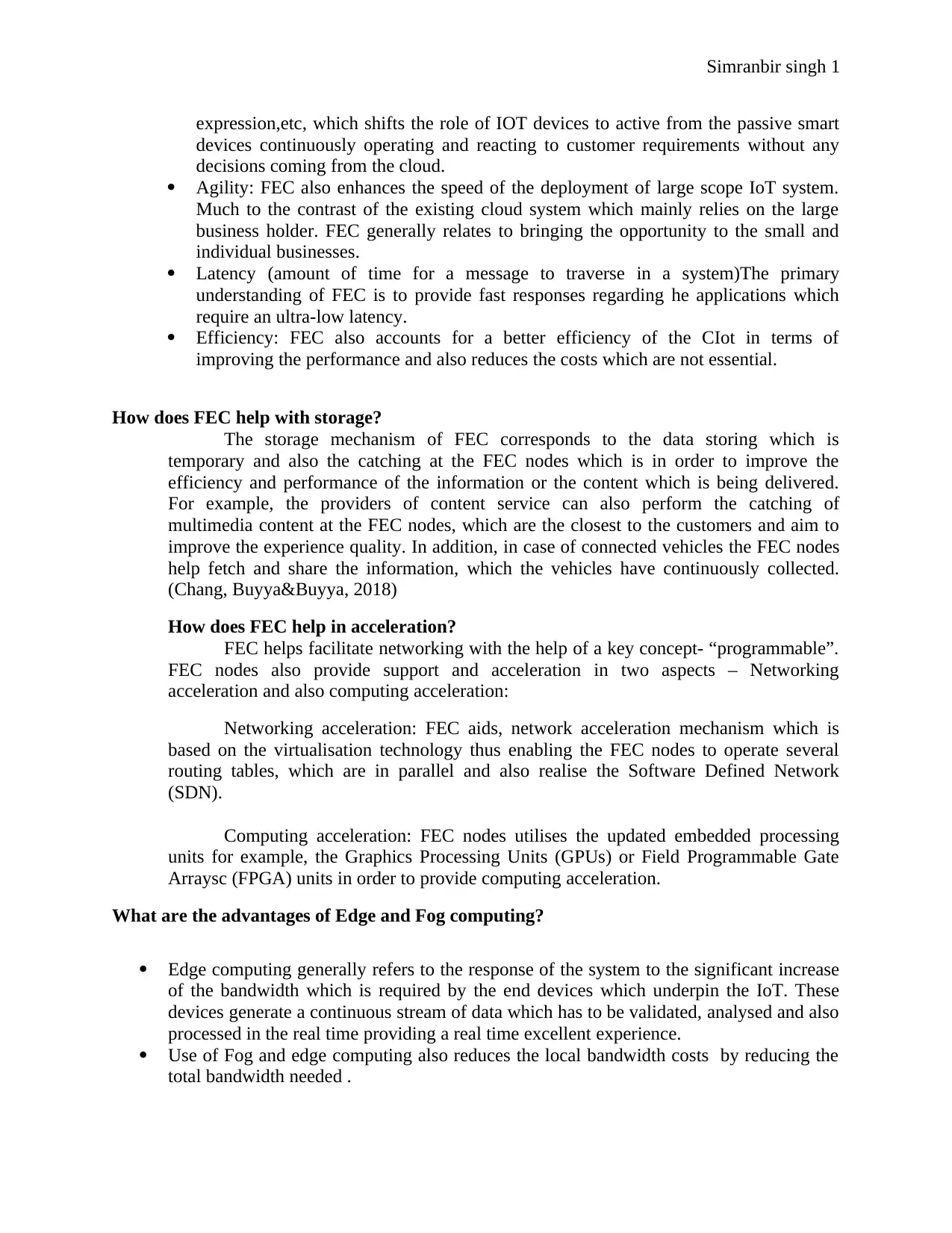
Simranbir singh 1
expression,etc, which shifts the role of IOT devices to active from the passive smart
devices continuously operating and reacting to customer requirements without any
decisions coming from the cloud.
Agility: FEC also enhances the speed of the deployment of large scope IoT system.
Much to the contrast of the existing cloud system which mainly relies on the large
business holder. FEC generally relates to bringing the opportunity to the small and
individual businesses.
Latency (amount of time for a message to traverse in a system)The primary
understanding of FEC is to provide fast responses regarding he applications which
require an ultra-low latency.
Efficiency: FEC also accounts for a better efficiency of the CIot in terms of
improving the performance and also reduces the costs which are not essential.
How does FEC help with storage?
The storage mechanism of FEC corresponds to the data storing which is
temporary and also the catching at the FEC nodes which is in order to improve the
efficiency and performance of the information or the content which is being delivered.
For example, the providers of content service can also perform the catching of
multimedia content at the FEC nodes, which are the closest to the customers and aim to
improve the experience quality. In addition, in case of connected vehicles the FEC nodes
help fetch and share the information, which the vehicles have continuously collected.
(Chang, Buyya&Buyya, 2018)
How does FEC help in acceleration?
FEC helps facilitate networking with the help of a key concept- “programmable”.
FEC nodes also provide support and acceleration in two aspects – Networking
acceleration and also computing acceleration:
Networking acceleration: FEC aids, network acceleration mechanism which is
based on the virtualisation technology thus enabling the FEC nodes to operate several
routing tables, which are in parallel and also realise the Software Defined Network
(SDN).
Computing acceleration: FEC nodes utilises the updated embedded processing
units for example, the Graphics Processing Units (GPUs) or Field Programmable Gate
Arraysc (FPGA) units in order to provide computing acceleration.
What are the advantages of Edge and Fog computing?
Edge computing generally refers to the response of the system to the significant increase
of the bandwidth which is required by the end devices which underpin the IoT. These
devices generate a continuous stream of data which has to be validated, analysed and also
processed in the real time providing a real time excellent experience.
Use of Fog and edge computing also reduces the local bandwidth costs by reducing the
total bandwidth needed .
expression,etc, which shifts the role of IOT devices to active from the passive smart
devices continuously operating and reacting to customer requirements without any
decisions coming from the cloud.
Agility: FEC also enhances the speed of the deployment of large scope IoT system.
Much to the contrast of the existing cloud system which mainly relies on the large
business holder. FEC generally relates to bringing the opportunity to the small and
individual businesses.
Latency (amount of time for a message to traverse in a system)The primary
understanding of FEC is to provide fast responses regarding he applications which
require an ultra-low latency.
Efficiency: FEC also accounts for a better efficiency of the CIot in terms of
improving the performance and also reduces the costs which are not essential.
How does FEC help with storage?
The storage mechanism of FEC corresponds to the data storing which is
temporary and also the catching at the FEC nodes which is in order to improve the
efficiency and performance of the information or the content which is being delivered.
For example, the providers of content service can also perform the catching of
multimedia content at the FEC nodes, which are the closest to the customers and aim to
improve the experience quality. In addition, in case of connected vehicles the FEC nodes
help fetch and share the information, which the vehicles have continuously collected.
(Chang, Buyya&Buyya, 2018)
How does FEC help in acceleration?
FEC helps facilitate networking with the help of a key concept- “programmable”.
FEC nodes also provide support and acceleration in two aspects – Networking
acceleration and also computing acceleration:
Networking acceleration: FEC aids, network acceleration mechanism which is
based on the virtualisation technology thus enabling the FEC nodes to operate several
routing tables, which are in parallel and also realise the Software Defined Network
(SDN).
Computing acceleration: FEC nodes utilises the updated embedded processing
units for example, the Graphics Processing Units (GPUs) or Field Programmable Gate
Arraysc (FPGA) units in order to provide computing acceleration.
What are the advantages of Edge and Fog computing?
Edge computing generally refers to the response of the system to the significant increase
of the bandwidth which is required by the end devices which underpin the IoT. These
devices generate a continuous stream of data which has to be validated, analysed and also
processed in the real time providing a real time excellent experience.
Use of Fog and edge computing also reduces the local bandwidth costs by reducing the
total bandwidth needed .

Simranbir singh 1
Edge computing also has the ability to bolster cyber defences mostly because certain
security measures such as inscription are implemented in the local network.
What are the disadvantages?
Edge and fog computing can also make the entire network and the system a bit more
complicated, increasing the time taken for the root analysis.
Furthermore, with the increase in the edge and fog computing processing capabilities are
moved to a decentralised location.
Edge devices also have a higher number of refresh cycles (length of time that passes
between installations) which results in the lock in of architecture designs.
What are the required educational tools?
In order to teach fog and edge, computing the primary requirement will be the use
of a computer present. Secondly, a local area network would be highly appreciated as it
can actually be used to demonstrate certain factors. Other than that, a proper theoretical
understanding of the various platforms and the details and applications of Fog and edge
computing need to be included. Both vertical and horizontal networking (corporate
business unites and between companies) need to be explained with proper demonstration.
The architecture required for fog and edge computing also needs to be properly
established. (Butler, 2018)
What are the various networking connectivity of FEC that is a must to know?
Networking of FEC involves both horizontal and vertical connectivity (Butler,
2018). Vertical networking interconnects the things and the cloud with the IP networks
which needs proper demonstration for a clear understanding. On the other hand,
horizontal networking is generally heterogeneous in nature, and the network signals and
protocols depend on the supported and specified hardware of the FEC nodes.
What is the Architecture of Fog and Edge computing?
The Fog and Edge computing has three different edge layers:
1. Inner edge
2. Middle edge
3. Outer edge
Edge computing also has the ability to bolster cyber defences mostly because certain
security measures such as inscription are implemented in the local network.
What are the disadvantages?
Edge and fog computing can also make the entire network and the system a bit more
complicated, increasing the time taken for the root analysis.
Furthermore, with the increase in the edge and fog computing processing capabilities are
moved to a decentralised location.
Edge devices also have a higher number of refresh cycles (length of time that passes
between installations) which results in the lock in of architecture designs.
What are the required educational tools?
In order to teach fog and edge, computing the primary requirement will be the use
of a computer present. Secondly, a local area network would be highly appreciated as it
can actually be used to demonstrate certain factors. Other than that, a proper theoretical
understanding of the various platforms and the details and applications of Fog and edge
computing need to be included. Both vertical and horizontal networking (corporate
business unites and between companies) need to be explained with proper demonstration.
The architecture required for fog and edge computing also needs to be properly
established. (Butler, 2018)
What are the various networking connectivity of FEC that is a must to know?
Networking of FEC involves both horizontal and vertical connectivity (Butler,
2018). Vertical networking interconnects the things and the cloud with the IP networks
which needs proper demonstration for a clear understanding. On the other hand,
horizontal networking is generally heterogeneous in nature, and the network signals and
protocols depend on the supported and specified hardware of the FEC nodes.
What is the Architecture of Fog and Edge computing?
The Fog and Edge computing has three different edge layers:
1. Inner edge
2. Middle edge
3. Outer edge
Paraphrase This Document
Need a fresh take? Get an instant paraphrase of this document with our AI Paraphraser
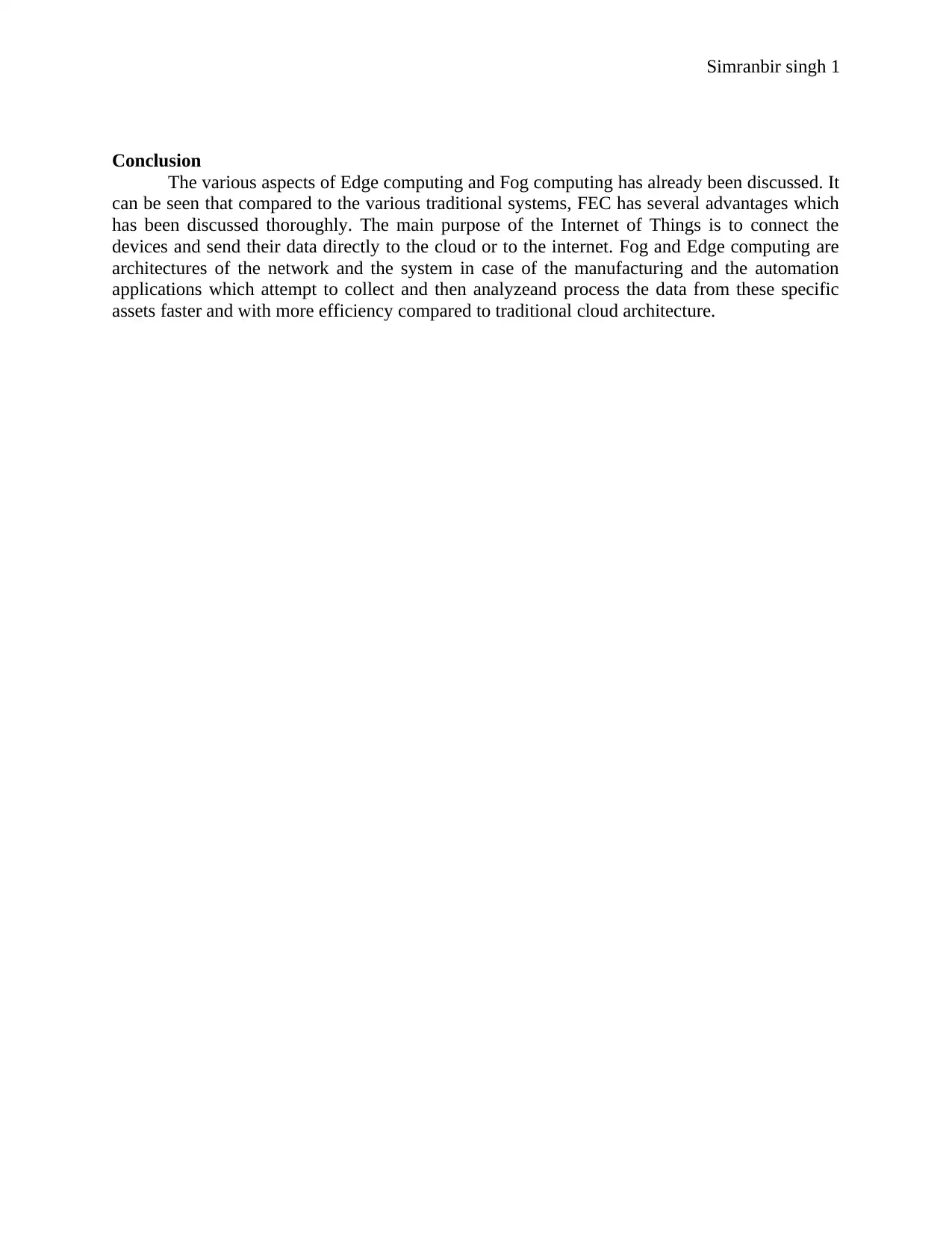
Simranbir singh 1
Conclusion
The various aspects of Edge computing and Fog computing has already been discussed. It
can be seen that compared to the various traditional systems, FEC has several advantages which
has been discussed thoroughly. The main purpose of the Internet of Things is to connect the
devices and send their data directly to the cloud or to the internet. Fog and Edge computing are
architectures of the network and the system in case of the manufacturing and the automation
applications which attempt to collect and then analyzeand process the data from these specific
assets faster and with more efficiency compared to traditional cloud architecture.
Conclusion
The various aspects of Edge computing and Fog computing has already been discussed. It
can be seen that compared to the various traditional systems, FEC has several advantages which
has been discussed thoroughly. The main purpose of the Internet of Things is to connect the
devices and send their data directly to the cloud or to the internet. Fog and Edge computing are
architectures of the network and the system in case of the manufacturing and the automation
applications which attempt to collect and then analyzeand process the data from these specific
assets faster and with more efficiency compared to traditional cloud architecture.
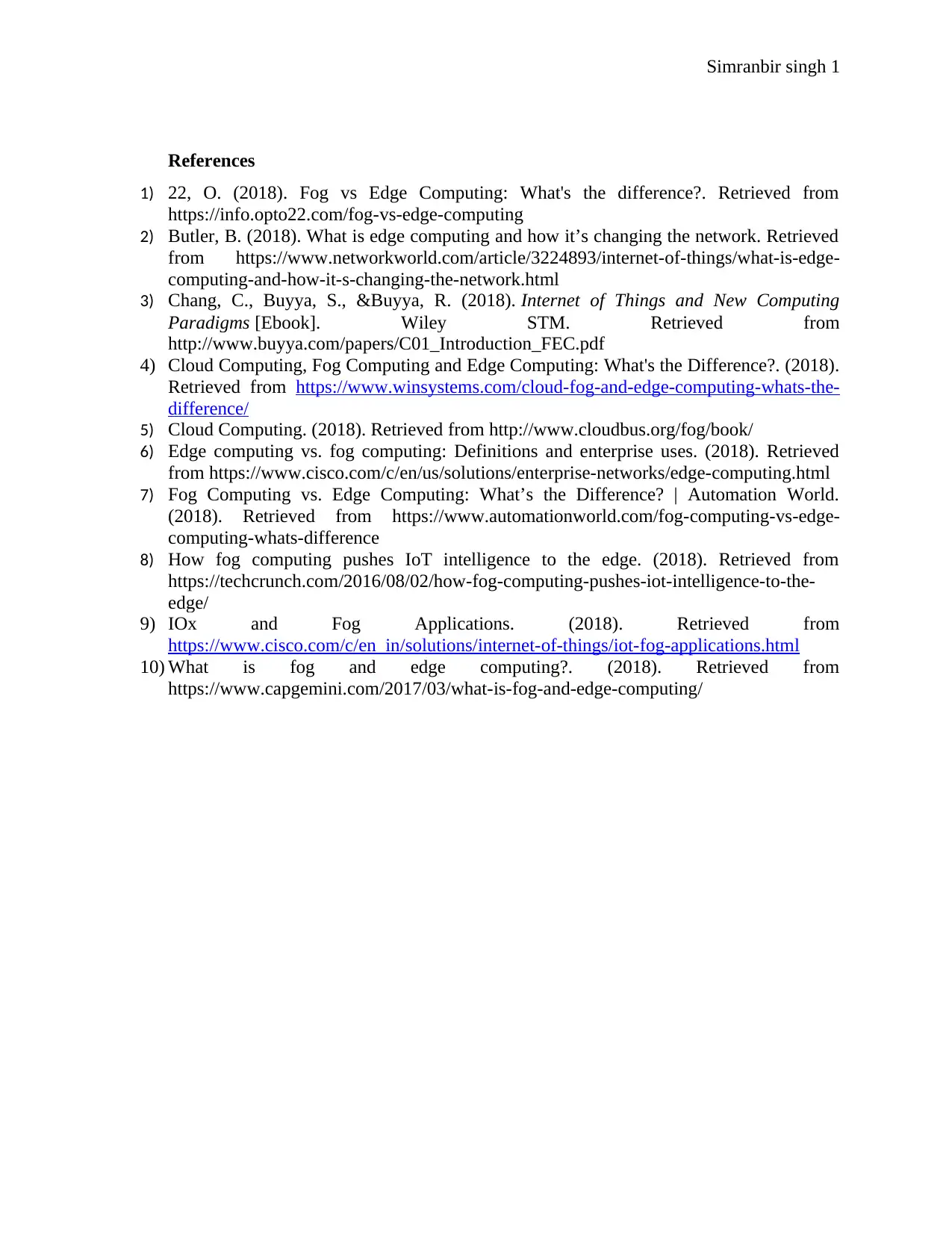
Simranbir singh 1
References
1) 22, O. (2018). Fog vs Edge Computing: What's the difference?. Retrieved from
https://info.opto22.com/fog-vs-edge-computing
2) Butler, B. (2018). What is edge computing and how it’s changing the network. Retrieved
from https://www.networkworld.com/article/3224893/internet-of-things/what-is-edge-
computing-and-how-it-s-changing-the-network.html
3) Chang, C., Buyya, S., &Buyya, R. (2018). Internet of Things and New Computing
Paradigms [Ebook]. Wiley STM. Retrieved from
http://www.buyya.com/papers/C01_Introduction_FEC.pdf
4) Cloud Computing, Fog Computing and Edge Computing: What's the Difference?. (2018).
Retrieved from https://www.winsystems.com/cloud-fog-and-edge-computing-whats-the-
difference/
5) Cloud Computing. (2018). Retrieved from http://www.cloudbus.org/fog/book/
6) Edge computing vs. fog computing: Definitions and enterprise uses. (2018). Retrieved
from https://www.cisco.com/c/en/us/solutions/enterprise-networks/edge-computing.html
7) Fog Computing vs. Edge Computing: What’s the Difference? | Automation World.
(2018). Retrieved from https://www.automationworld.com/fog-computing-vs-edge-
computing-whats-difference
8) How fog computing pushes IoT intelligence to the edge. (2018). Retrieved from
https://techcrunch.com/2016/08/02/how-fog-computing-pushes-iot-intelligence-to-the-
edge/
9) IOx and Fog Applications. (2018). Retrieved from
https://www.cisco.com/c/en_in/solutions/internet-of-things/iot-fog-applications.html
10) What is fog and edge computing?. (2018). Retrieved from
https://www.capgemini.com/2017/03/what-is-fog-and-edge-computing/
References
1) 22, O. (2018). Fog vs Edge Computing: What's the difference?. Retrieved from
https://info.opto22.com/fog-vs-edge-computing
2) Butler, B. (2018). What is edge computing and how it’s changing the network. Retrieved
from https://www.networkworld.com/article/3224893/internet-of-things/what-is-edge-
computing-and-how-it-s-changing-the-network.html
3) Chang, C., Buyya, S., &Buyya, R. (2018). Internet of Things and New Computing
Paradigms [Ebook]. Wiley STM. Retrieved from
http://www.buyya.com/papers/C01_Introduction_FEC.pdf
4) Cloud Computing, Fog Computing and Edge Computing: What's the Difference?. (2018).
Retrieved from https://www.winsystems.com/cloud-fog-and-edge-computing-whats-the-
difference/
5) Cloud Computing. (2018). Retrieved from http://www.cloudbus.org/fog/book/
6) Edge computing vs. fog computing: Definitions and enterprise uses. (2018). Retrieved
from https://www.cisco.com/c/en/us/solutions/enterprise-networks/edge-computing.html
7) Fog Computing vs. Edge Computing: What’s the Difference? | Automation World.
(2018). Retrieved from https://www.automationworld.com/fog-computing-vs-edge-
computing-whats-difference
8) How fog computing pushes IoT intelligence to the edge. (2018). Retrieved from
https://techcrunch.com/2016/08/02/how-fog-computing-pushes-iot-intelligence-to-the-
edge/
9) IOx and Fog Applications. (2018). Retrieved from
https://www.cisco.com/c/en_in/solutions/internet-of-things/iot-fog-applications.html
10) What is fog and edge computing?. (2018). Retrieved from
https://www.capgemini.com/2017/03/what-is-fog-and-edge-computing/
1 out of 9
Related Documents
Your All-in-One AI-Powered Toolkit for Academic Success.
+13062052269
info@desklib.com
Available 24*7 on WhatsApp / Email
![[object Object]](/_next/static/media/star-bottom.7253800d.svg)
Unlock your academic potential
© 2024 | Zucol Services PVT LTD | All rights reserved.



